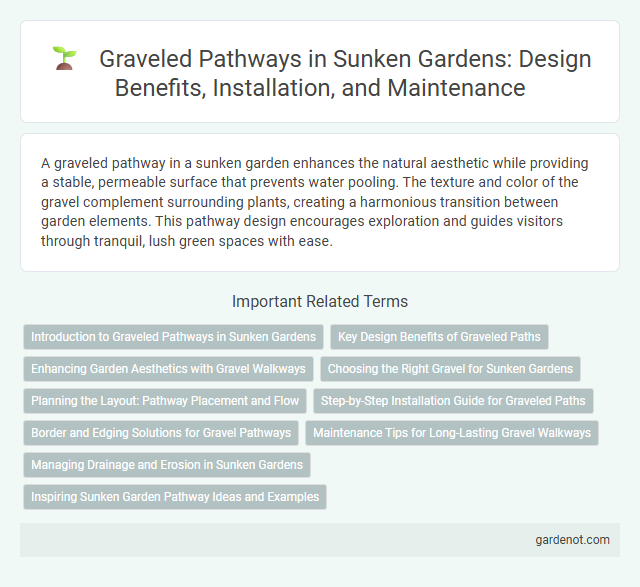A graveled pathway in a sunken garden enhances the natural aesthetic while providing a stable, permeable surface that prevents water pooling. The texture and color of the gravel complement surrounding plants, creating a harmonious transition between garden elements. This pathway design encourages exploration and guides visitors through tranquil, lush green spaces with ease.
Introduction to Graveled Pathways in Sunken Gardens
Graveled pathways in sunken gardens provide durable, permeable surfaces that enhance water drainage and reduce soil erosion. These pathways often consist of compacted gravel layers that maintain stability while allowing plant roots to breathe and absorb moisture. Their textured appearance complements the natural aesthetic of sunken gardens, guiding visitors through vibrant floral displays and tranquil landscapes.
Key Design Benefits of Graveled Paths
Graveled pathways in sunken gardens enhance drainage by allowing water to permeate through the surface, preventing puddles and soil erosion. These paths offer flexibility in design, easily contouring to natural garden slopes and creating fluid, organic walkways. Their porous texture provides slip resistance, ensuring safe walking surfaces even after rain.
Enhancing Garden Aesthetics with Gravel Walkways
Graveled pathways in a sunken garden provide a textured, visually appealing contrast to lush greenery and vibrant flower beds, enhancing the overall landscape design. The use of natural gravel materials improves drainage and reduces soil erosion, ensuring longevity and low maintenance for garden walkways. Integrating gravel walkways also creates clear, inviting paths that guide visitors through the garden's tranquil environment while complementing its natural aesthetics.
Choosing the Right Gravel for Sunken Gardens
Selecting the right gravel for sunken gardens hinges on factors such as drainage, texture, and color to enhance both function and aesthetics. Pea gravel offers smoothness and excellent drainage, while crushed granite provides a sturdy, textured surface ideal for pathways. Opting for naturally rounded, weather-resistant stones ensures longevity and complements the lush, layered planting typical of sunken garden designs.
Planning the Layout: Pathway Placement and Flow
Careful planning of the gravel pathway layout in a sunken garden enhances both functionality and aesthetics by ensuring smooth movement and natural flow. Positioning pathways around key features like water elements, seating areas, and plant beds creates intuitive navigation while maintaining harmonious spatial balance. Optimizing pathway width and curvature accommodates foot traffic and complements the garden's sunken contours for an immersive experience.
Step-by-Step Installation Guide for Graveled Paths
Begin the installation of gravely pathways in a sunken garden by first marking the desired path layout and excavating to a depth of 4 to 6 inches, ensuring proper drainage. Next, lay a geotextile fabric to prevent weed growth and spread a 2 to 3-inch layer of crushed stone or gravel as a stable base; then compact the base firmly using a tamper or plate compactor. Finally, top the pathway with a 1 to 2-inch layer of finer decorative gravel, level evenly, and edge with metal or stone borders to maintain the pathway's shape and prevent spreading.
Border and Edging Solutions for Gravel Pathways
Graveled pathways in sunken gardens benefit from strong border and edging solutions such as natural stone, metal, or timber to prevent gravel displacement and maintain a clean, defined edge. Durable edging materials not only enhance the garden's aesthetic but also improve drainage and reduce weed growth along the pathway. Proper installation of borders ensures long-term pathway stability and preserves the sunken garden's structured design.
Maintenance Tips for Long-Lasting Gravel Walkways
Regularly removing weeds and debris from gravel pathways in the sunken garden prevents deterioration and maintains a clean appearance. Applying a fresh layer of gravel every 1-2 years helps restore proper drainage and prevents uneven surfaces. Proper edging installation supports containment, reducing gravel displacement and preserving walkway integrity.
Managing Drainage and Erosion in Sunken Gardens
Graveled pathways in sunken gardens are essential for managing drainage and minimizing erosion by allowing water to permeate through the surface and reducing runoff. Proper installation with a gravel base and slope design ensures efficient water flow, preventing soil displacement and maintaining the garden's structural integrity. Regular maintenance, such as replenishing gravel and clearing debris, enhances drainage performance and preserves the pathway's durability.
Inspiring Sunken Garden Pathway Ideas and Examples
Graveled pathways in sunken gardens create a rustic and natural aesthetic, enhancing the serene atmosphere while providing excellent drainage and easy maintenance. Incorporating curved or meandering gravel paths encourages exploration and highlights various garden features such as vibrant flower beds, water elements, and sculptural accents. Using contrasting gravel colors or combining gravel with stepping stones adds texture and visual interest, transforming the sunken garden into a tranquil retreat with distinct, inviting walkways.
Graveled pathway Infographic

 gardenot.com
gardenot.com